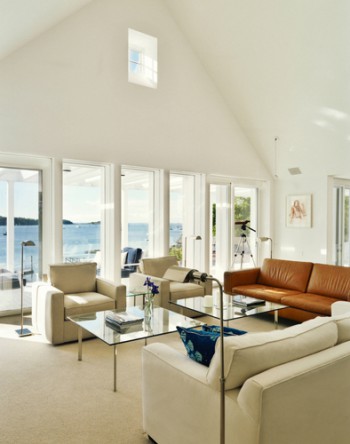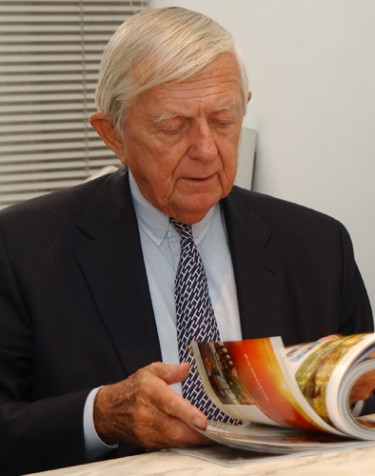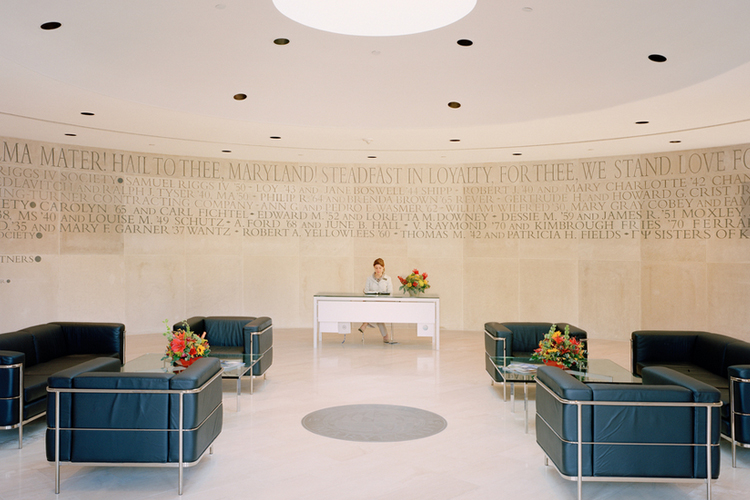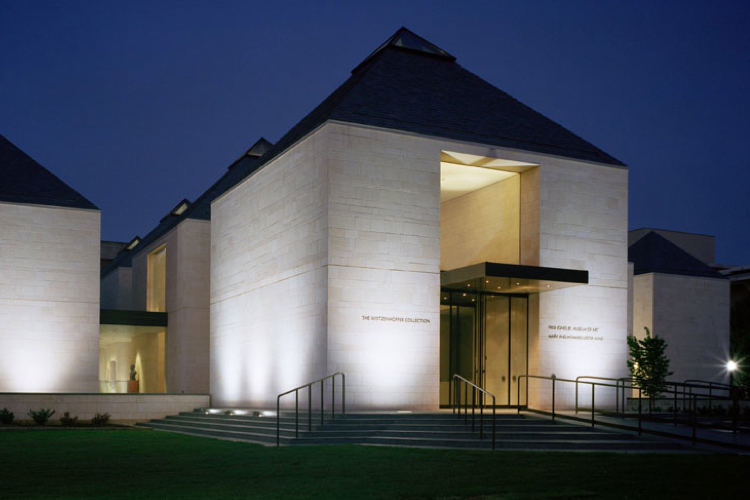An Architectural Fixture
[rev_slider Jacobsen]
For someone who’s called a minimalist, his portfolio brims with details; for a man of modest physical stature, he’s reached iconic proportions in the world of architecture. Hugh Newell Jacobsen ’48 has spent 45 years building on his passion for pure architectural design.
“If I’m remembered for anything, it will be that,” Jacobsen says, pointing to 136 sheets of line drawings for his latest building project—a $16 million museum he designed specifically to house and display 40 French impressionist paintings at the University of Oklahoma, an acquisition the university openly declares “the most important collection of art given to an American public university,” valued at $78 million. The building’s exterior is Texas limestone, the “color of French unsalted butter.”
To date, Jacobsen has designed 450 buildings in 28 states and 9 foreign countries, including additions to the U.S. Capitol Building (west terraces and below-grade), and Jacqueline Onassis’s Martha’s Vineyard house—just to name names.
Jacobsen has received more than 110 design awards, including six National Honor Awards, the highest national award given by the American Institute of Architects. And he’s been named one of the top 100 designers in the world four times by Architectural Digest.
Two museums have exhibited retrospectives of his work: one in Sao Paolo, Brazil, and another at National Building Museum in Washington, D.C. He is currently awaiting publication of a third monograph, which will chronicle, with stunning photography, his architecture from 1994 to 2005.
It’s nice to get recognition,” says Jacobsen, “but people like to hold up buildings and put them on pedestals. Let’s keep the building on the podium, and reserve the pedestal for a beautiful woman.”
His “minimalist” design style is best described with words like clean, and serene, rather than cold or sterile. When designing a residence, Jacobsen works with his clients to create determinedly “family friendly” residences, often warmed by natural elements like hard-wood flooring, fireplaces, lots of books, and maximized natural lighting—an essential component in his design.

The interior of the Steinglass Residence at Rockport, Maine.
Photo by Richard Mandelkorn.
Long before the advent of computers or CAD training, Jacobsen was schooled in the traditional curriculum—reading, writing, and arithmetic. Far from top of the class, he struggled through school in Grand Rapids, Mich., with an undiagnosed disability. “They didn’t diagnose dyslexia back then. They gave me D’s just to get rid of me.”
After relocating to the Washington, D.C., area with his family, Jacobsen expected to attend college, as his parents had done and his friends were doing. He applied to seven universities; all of them turned him down. Not knowing where else to turn, and feeling “lower than a snake’s belly-button,” Jacobsen decided to try the business administration courses being offered by a startup Montgomery Junior College. It was 1947.
A year earlier, the Montgomery College history records show: “A committee formed to explore the need for a public junior college to help WWII veterans adjust to a post-war society.” And by September, the College opened evening and Saturday classes, which were held in the basement of Bethesda-Chevy Chase High School. Jacobsen remembers his classmates clearly; through his 18-year-old eyes, he saw them as “old men,” later realizing they were all of 25 or 26, just returned from the war.
After one semester, Jacobsen was accepted at the University of Maryland. There, he changed his major from business to fine arts, and earned a B.A. in 1951. “My father found out about it when I showed him my diploma! He must’ve wondered what all those paintings were doing around the house.”
Earning a bachelor’s degree was just the beginning of Jacobsen’s professional education. Almost by accident, he discovered architecture sitting in a lecture class where the professor diverted to architectural theory. For the first time, he heard why and how buildings serve mankind. It was the moment he experienced his epiphany. Intuitively and instantly, he knew he would become an architect.

Photo by Don Rejonis.
Today, Jacobsen’s home base remains Washington, D.C. When he’s in town, he walks to work, located just down the street in an unassuming gray townhouse in Georgetown. Occasionally, he finds opportunities to work on local projects, which allow him to take “a lovely lady,” his wife, to lunch, and make day trips to building sites.
Just over the line in Virginia, for example, he’s been working with John Kent Cooke, a former owner and president of the Washington Redskins, on the new Boxwood Winery. Comprising four buildings, including a reception building for wine tasting and a circular underground cave housing oak barrels, the winery design is modern, but it is being constructed with materials characteristic of the 18th century rural area of Middleburg, including field stone from the historic Boxwood Farm, and standing seam metal roofs. His work will be featured on the Boxwood label.
Another project close to Jacobsen’s heart and home is the University of Maryland’s Samuel Riggs Alumni Center, scheduled to open in winter 2005. The $30 million, 69,000-square-foot center houses a 500-seat alumni hall, office and meeting space, a club, and gardens. For his alma mater, Jacobsen worked with a theme of connectedness: “connections to Maryland’s past, connections to the arts and sports, connections between the exterior gardens and the interior spaces.”

The interior of the University of Maryland Alumni Center. Photo courtesy jacobsenarchitecture.com.
Rather than rest on his accomplishments, Jacobsen looks forward to the opportunity to try it again. He points to a small metal plate engraved in Sanskrit, lying on his desk. He translates: “To live a full life, you must leave some record.” By that simple directive, Hugh Jacobsen could have retired years ago; he’s just having too much fun to stop now.
—Tina Kramer
This article first appeared in the fall 2004 issue of Insights.



